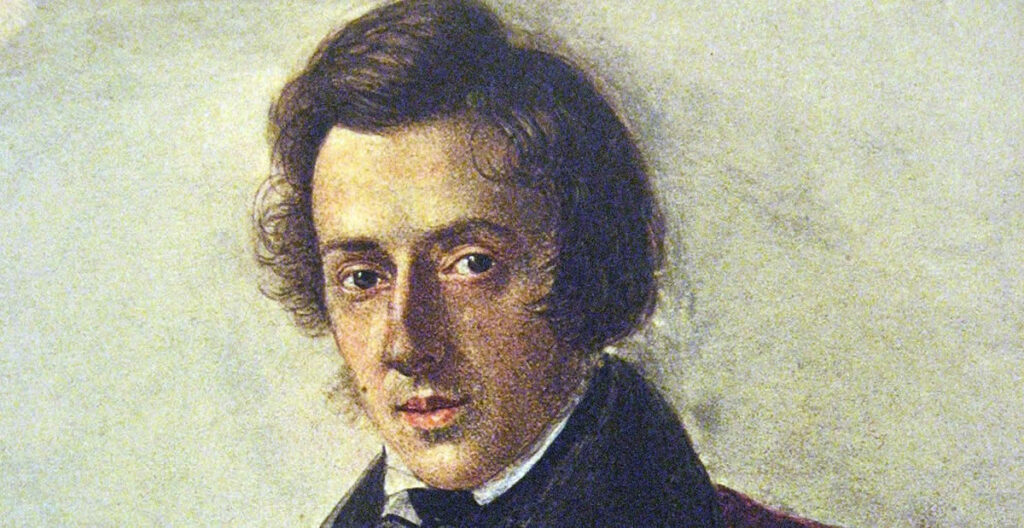Frédéric Chopin, the Polish composer and virtuoso pianist, is celebrated for his profound contribution to piano music. His compositions are characterized by poetic expressiveness, technical brilliance, and innovative use of harmony. Here is an exploration of ten of his most revered works, each showcasing a different facet of his genius.
1. Nocturne in E-flat Major, Op. 9, No. 2
The Nocturne in E-flat Major, Op. 9, No. 2, epitomizes Chopin’s lyrical style. Composed in 1830-1832, this nocturne captivates with its serene melody, flowing accompaniment, and intricate ornamentation. It’s a quintessential example of his ability to create a singing tone on the piano, resembling an operatic aria.
2. Ballade No. 1 in G Minor, Op. 23
The Ballade No. 1 in G Minor, Op. 23, is renowned for its dramatic narrative and technical demands. Written in 1835-1836, it unfolds like a story, with contrasting themes that evolve throughout the piece. The ballade’s climactic ending is particularly memorable, requiring both emotional depth and virtuosic skill.
3. Étude in C Minor, Op. 10, No. 12 (“Revolutionary”)
Composed during the November Uprising of 1831, the Étude in C Minor, Op. 10, No. 12, commonly known as the “Revolutionary Étude,” is a powerful and fiery work. Its relentless left-hand arpeggios and dramatic intensity reflect Chopin’s patriotic fervor and the turmoil of his homeland.
4. Piano Sonata No. 2 in B-flat Minor, Op. 35 (“Funeral March”)
The Piano Sonata No. 2 in B-flat Minor, Op. 35, composed in 1839, is notable for its famous third movement, the “Funeral March.” This sonata is a monumental work that juxtaposes the somber, processional march with a contrasting, tempestuous finale, showcasing Chopin’s mastery of large-scale structure and emotional contrast.
5. Polonaise in A-flat Major, Op. 53 (“Heroic”)
The Polonaise in A-flat Major, Op. 53, often called the “Heroic Polonaise,” is a testament to Chopin’s nationalist spirit and his innovative approach to the traditional Polish dance form. Composed in 1842, it features a grand, majestic opening theme, a vigorous middle section, and an exuberant, triumphant conclusion.
6. Prelude in D-flat Major, Op. 28, No. 15 (“Raindrop”)
The Prelude in D-flat Major, Op. 28, No. 15, nicknamed the “Raindrop Prelude,” is part of Chopin’s collection of 24 Preludes composed between 1835 and 1839. This prelude is characterized by a persistent, repetitive note that evokes the sound of raindrops, contrasting with a turbulent middle section that suggests a sudden storm.
7. Mazurka in A Minor, Op. 17, No. 4
Chopin’s Mazurka in A Minor, Op. 17, No. 4, composed in 1833, reflects his deep connection to Polish folk music. This mazurka combines a plaintive, melancholic melody with dance-like rhythms, showcasing his ability to infuse traditional forms with profound emotional depth.
8. Fantaisie-Impromptu in C-sharp Minor, Op. 66
The Fantaisie-Impromptu in C-sharp Minor, Op. 66, composed in 1834 and published posthumously, is a dazzling display of virtuosity and lyrical beauty. Its contrasting sections—an agitated, rapid first theme followed by a lyrical, dreamlike second theme—highlight Chopin’s gift for blending technical challenges with expressive content.
9. Waltz in D-flat Major, Op. 64, No. 1 (“Minute Waltz”)
The Waltz in D-flat Major, Op. 64, No. 1, known as the “Minute Waltz,” is a charming and exuberant piece composed in 1847. Despite its nickname, it’s not intended to be played in one minute; rather, it captures a light, playful character with its rapid tempo and intricate, sparkling passages.
10. Barcarolle in F-sharp Major, Op. 60
Composed in 1845-1846, the Barcarolle in F-sharp Major, Op. 60, is one of Chopin’s most sophisticated and mature works. Inspired by the gentle rocking motion of a Venetian gondola, this piece combines a lyrical, flowing melody with rich harmonic textures, demonstrating his unparalleled ability to evoke a sense of place and atmosphere.
Conclusion
Frédéric Chopin’s compositions continue to captivate pianists and audiences alike with their emotional depth, technical brilliance, and innovative harmonic language. From the intimate lyricism of his nocturnes to the heroic grandeur of his polonaises, each piece offers a unique glimpse into his artistic soul. Whether exploring the poetic simplicity of his preludes or the complex narrative of his sonatas, Chopin’s music remains a cornerstone of the piano repertoire, celebrated for its timeless beauty and expressive power.


Comments are closed